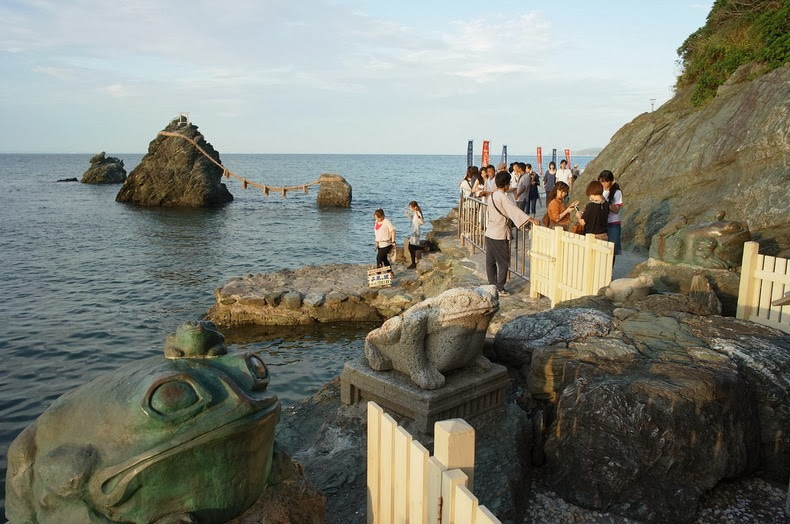Meoto Iwa, the Wedded Rocks

Meoto Iwa, also called the “husband and wife rocks” or “wedded rocks”, are a pair of small rocky stacks in the sea right in front of the Futami Okitama-jinja Shrine in Futami Bay, Japan. According to Shinto beliefs, the rocks represent the union of the creator of kami – the spirits, and therefore, celebrate the union in marriage of man and woman.
The larger rock, named Izanagi, is the husband and stands 9 meters tall with a girth of about 40 meters. Izanagi has a small Shinto torii gate on its peak. To his right is the 3.6 meter high “wife”, Izanami, which is about 9 meters round. Being married, they are joined by the distinctive sacred ropes particular to Shinto shrines and holy places, made of braided rice stalks called Shimenawa. The ropes biding the two rocks weigh almost a ton, and are replaced in a special ceremony held three times a year, in May, September and December.
During these ceremonies, local villagers rebuild the five four-inch diameter ropes, each 115-foot-long that connect and encircle the rocks. The rope changing ceremonies are deemed important enough to make the news each time.
Based on an old print in the possession of the shrine, the ropes were hung at least as early as the fourteenth century. But the name “meoto” is from the Meiji period; it was previously called takeishizaki. In ancient times, there was only a very small shrine that was replaced by larger shrines over time. The current main shrine is made of concrete and stands right on the rocky shore. Waves and storms routinely wash over the entire shrine, as the buildings are located at the outermost tip of a mountain outcrop.
Meoto Iwa is celebrated today as a shrine for marriages, and it’s not uncommon to see couples praying before the two deities in the hopes their marriage will be as strong and as lasting. The best time to see the rocks is at dawn during the summer, when the sun appears to rise between them. Mount Fuji is visible in the distance. At low tide the rocks no longer appear separated by water, though a strip of land connected to the mainland makes it possible to walk up close to them.
Right next to the best viewing spot for the sacred Meoto Iwa is the equally important Futami Okitama Shrine. Around the shrine are myriad sculptures of frogs donated by worshippers praying for the safe return of a loved one.
Meoto Iwa, the Wedded Rocks

Meoto Iwa, the Wedded Rocks

Meoto Iwa, the Wedded Rocks

Meoto Iwa, the Wedded Rocks

Meoto Iwa, the Wedded Rocks

Meoto Iwa, the Wedded Rocks

Source: Wikipedia, Japan Travel, Shinto Shrines of Japan

No comments:
Post a Comment
Note: only a member of this blog may post a comment.